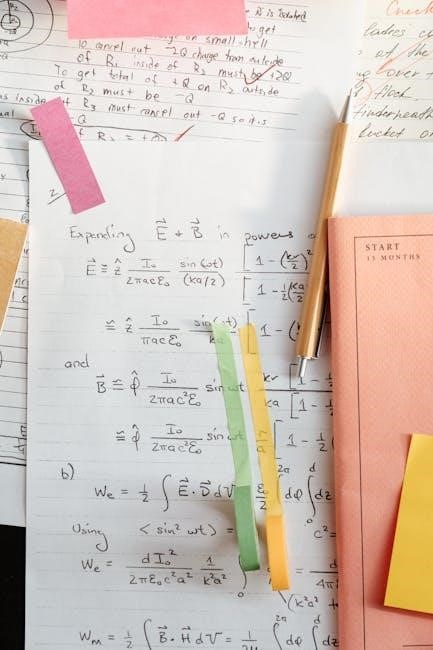The introduction to solving radical equations involves understanding variables inside radicals, using
algebraic manipulation
to isolate them, and applying rules to simplify equations with radicals, as seen in online worksheets and study guides available today easily․
Definition and Importance of Radical Equations
Radical equations are defined as equations that contain a variable inside a radical sign, such as square roots or cube roots, and are used to model real-world phenomena, including population growth, financial transactions, and scientific experiments․ The importance of radical equations lies in their ability to describe complex relationships between variables, allowing for more accurate predictions and problem-solving․ In mathematics, radical equations are a fundamental concept, and understanding how to solve them is crucial for advancing in algebra and other mathematical disciplines․ Online resources, such as worksheets and study guides, provide a comprehensive introduction to radical equations, including their definition, importance, and application in various fields․ By studying radical equations, students can develop problem-solving skills, critical thinking, and analytical abilities, which are essential for success in mathematics and other areas of study․ Radical equations have numerous practical applications, making them a vital part of mathematics education․
Algebra I and Algebra II Connection
The connection between Algebra I and Algebra II is evident in the study of radical equations, as concepts learned in Algebra I, such as solving linear and quadratic equations, lay the foundation for more advanced topics in Algebra II․ Radical equations, in particular, require a strong understanding of algebraic principles, including equation manipulation and function analysis․ In Algebra I, students learn to solve equations with variables on one side, while in Algebra II, they build upon this knowledge to tackle more complex equations, including those with radicals․ Online resources, such as worksheets and study guides, often provide a review of Algebra I concepts before introducing radical equations, ensuring a smooth transition for students․ By recognizing the connection between Algebra I and Algebra II, students can better appreciate the progression of mathematical concepts and develop a deeper understanding of radical equations and their applications․ This connection is crucial for success in higher-level mathematics courses․

Types of Radical Equations
Radical equations are classified into simple and complex types, involving various roots and
algebraic expressions
that require different solution methods and techniques easily․
Simple Radical Equations
Simple radical equations involve a single radical term, such as a square root or cube root, and can be solved using basic algebraic techniques, including isolation of the variable and simplification of the equation․ These types of equations are often introduced in algebra classes and are a fundamental concept in mathematics․ Online resources, such as worksheets and study guides, provide examples and practice problems for solving simple radical equations․ The key to solving these equations is to isolate the radical term and then eliminate the radical by raising both sides of the equation to the appropriate power․ For example, if the equation involves a square root, raising both sides to the second power will eliminate the radical․ Simple radical equations are an important building block for more complex equations and are used in a variety of real-world applications, including physics and engineering․ By mastering simple radical equations, students can develop a strong foundation in algebra and problem-solving․
Complex Radical Equations with Multiple Solutions
Complex radical equations with multiple solutions involve equations with more than one radical term or equations that can be solved in multiple steps․ These types of equations require a deeper understanding of algebraic techniques and problem-solving strategies․ Online resources, such as worksheets and study guides, provide examples and practice problems for solving complex radical equations with multiple solutions․ The key to solving these equations is to carefully analyze the equation and determine the best approach, which may involve factoring, simplifying, or using other algebraic techniques․ Complex radical equations with multiple solutions can have more than one valid solution, and it is important to check each solution to ensure it is valid․ By practicing and mastering complex radical equations with multiple solutions, students can develop a strong foundation in algebra and problem-solving, and be better prepared to tackle more challenging math problems․ These types of equations are commonly found in advanced math classes and are used in a variety of real-world applications․

Methods for Solving Radical Equations
Methods include isolating variables and using algebraic manipulation to simplify equations with radicals using online resources and study guides effectively always․
Isolating the Variable
To solve radical equations, isolating the variable is crucial, and this can be achieved by using algebraic manipulation, such as adding, subtracting, multiplying, or dividing both sides of the equation by the same value․
The goal is to get the variable, often represented by a letter, on one side of the equation, and the constants on the other side, making it easier to solve for the variable․
This process may involve factoring, canceling out common factors, or using inverse operations to isolate the variable, and it is essential to be careful when working with radicals to avoid introducing extraneous solutions․
Online resources, such as worksheets and study guides, can provide helpful examples and exercises to practice isolating variables in radical equations, and they often include step-by-step solutions and explanations to help students understand the process․
By mastering the skill of isolating variables, students can become more confident and proficient in solving radical equations, and they can apply this skill to a wide range of mathematical problems and applications․

Isolating the variable is a fundamental step in solving radical equations, and it requires attention to detail and a solid understanding of algebraic concepts and operations․
Raising Both Sides to the nth Power
Raising both sides of the equation to the nth power is a common method used to solve radical equations, where n is the index of the radical, such as the square root or cube root․
This technique allows students to eliminate the radical sign and simplify the equation, making it easier to solve for the variable;
The process involves raising both sides of the equation to the power of n, which cancels out the radical, and then simplifying the resulting equation․
For example, if the equation is x + 2 = √(x + 5), raising both sides to the power of 2 would result in (x + 2)^2 = x + 5․
Online resources, such as worksheets and study guides, often provide examples and exercises that demonstrate this technique, and they can help students practice raising both sides to the nth power to solve radical equations․
By applying this method, students can develop their problem-solving skills and become more proficient in solving radical equations, which is an essential skill in algebra and other areas of mathematics․
This technique is widely used in mathematics and is an important tool for solving radical equations․

Worksheet Examples and Answers
Online resources offer various worksheets with examples and answers, providing students with practice opportunities for solving radical equations, including multiple-choice and free-response questions, with solutions․
Sample Problems and Solutions
Sample problems and solutions are essential components of worksheets, allowing students to practice and understand the concepts of solving radical equations․ These problems typically involve equations with variables inside radicals, and students must use algebraic manipulation to isolate the variable․ The solutions provided help students check their work and understand the steps involved in solving the equations․ Online resources offer a wide range of sample problems and solutions, including multiple-choice and free-response questions․ The problems may involve simple radical equations, such as those with square roots or cube roots, or more complex equations with higher-order roots․ By working through these sample problems and solutions, students can develop their skills and confidence in solving radical equations․ The worksheets often include a mix of straightforward and more challenging problems, allowing students to progress at their own pace and build their understanding of the subject․ This helps students to become proficient in solving radical equations․

